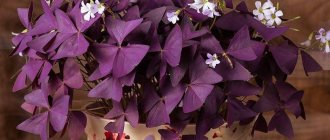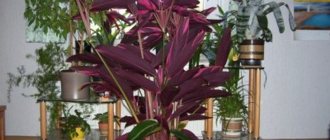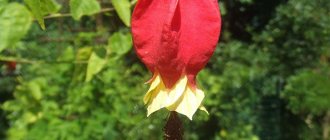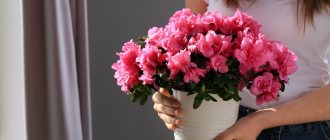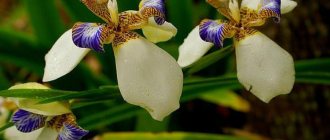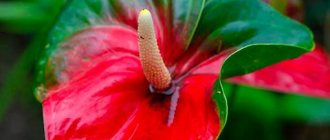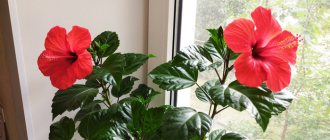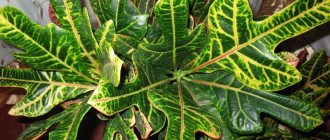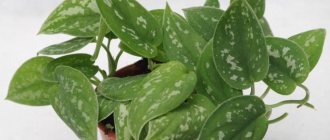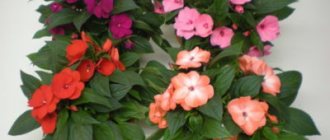Flowers with bright foliage at the top
A plant with brightly colored foliage is the goal of any gardener. If such a miracle is not yet in the apartment, then you can choose one of the listed copies:
- poinsettia;
- Cordyline;
- irezine;
- nidularium;
- triangular oxalis.
Indoor flower with red leaves - an original interior element
This is a list of the most popular plants that have red leaves at the top. To ensure that indoor plants are always pleasing to the eye and their color does not fade, you need to familiarize yourself with the nuances of care.
Poinsettia
Poinsettia, or Christmas star, as it is popularly called, is a variety of Euphorbiaceae. The second name arose due to the presence of bright red foliage at the top of the cap, which usually appears at the beginning of winter. The plant is native to Mexico and Central America. It has a number of subspecies:
- spherical;
- large-horned;
- sparkling.
Poinsettia
Poinsettia is not picky when it comes to care. The main thing is to place the plant in a place without drafts and avoid strong temperature changes. Feels uncomfortable in very hot weather and cannot tolerate strong shade. Grows well in diffused light. She needs to be provided with abundant watering and constant spraying. In winter, it sheds its leaves. During this period it looks unpresentable. Propagated by cuttings - shoots containing at least five leaves.
Important! Euphorbia poinsettia juice is poisonous. It may cause minor skin burns. All pruning and replanting procedures are performed with gloves.
Cordilina
A subshrub from the Agave family from the tropics resembles a palm tree. But it has nothing to do with palm trees. More likely, a relative of the dracaena. It grows up to half a meter in height.
It attracts with its unusual appearance, or rather with its elongated red leaves, which are tightly spaced in relation to each other. As it grows, the lower leaves fall off, and the upper ones form a chic hat. There are varieties of cordyline, differing in foliage colors:
- green;
- red and white.
Cordilina
Cordyline must be placed in a warm place where rays of diffused light fall. Does not like frequent watering. Optimal temperature:
- in summer 20-23 °C;
- in winter 13-17 °C.
It responds well to systematic moistening and annual replanting. Overmoistening is detrimental to cordyline.
Irezine
An unusually bright flower from the Amaranthaceae family. Most often found with leaves that have an epileptic shape and a red-burgundy color. In addition, there are varieties with greenish leaves with crimson veins.
Irezine
Irezine is unpretentious in care. It develops well in diffused light and does not respond to minor temperature changes. Can tolerate drought and low air humidity readings.
Nidularium
A house plant native to the tropics. Belongs to the Bromeliaceae family. The flower is distinguished by the absence of a stem. Sharp green leaves emerge directly from the base. Red leaf plates appear at the top of the plant during the flowering period.
Nidularium
After flowering, the rosette disappears, and in its place several new shoots appear, which also begin to bloom. In this way, nidularium multiplies quickly.
Important! The plant must be protected from direct sunlight, watered frequently and maintained at a high level of humidity.
Oxalis triangularis
The plant is stemless, belongs to the sorrel family, popularly known as hare cabbage. The foliage is carved, like clover, red with a purple tint. During the daytime, the leaves tend to rise, and in the evening they begin to fall. It has another name - Madame Butterfly because of the shape of the leaf, which resembles a butterfly.
Oxalis triangularis
Indoors, it is located in a place that is well lit. Otherwise, the color of the foliage will change, darken and approach a greenish tint. Watering should be moderate. Periodically in the spring and summer they are fed with liquid fertilizers. In winter, when at rest, it grows its crown.
Types of oxalis
Oxalis is very diverse, but only a few species have taken root in Russia. In indoor conditions, you can still experiment with breeding hybrids, but in the garden we advise you to stick to time-tested classics!
Common sorrel
The most common perennial species that grows in coniferous forests and gets along well with mushrooms. The palmate leaves are assembled from intricate heart-shaped fragments. The flowers are solitary, light, but with distinct dark veins.
Photo: goodhouse.ru
Variegated wood sorrel
A very unusual appearance with multi-colored buds - white with a burgundy border. Variegated varieties also differ in the shape of their leaves, which consist of thin, long parts. At night, the flowers curl into a tube.
Photo: zen.yandex.ru
Triangular oxalis
These are the same purple leaves that are so reminiscent of butterfly wings. This species is most often grown indoors. It looks even more bizarre during flowering, when long whitish tube buds bloom.
Photo: cvetyphoto.blogspot.com
Tuberous sorrel
It is an edible plant that is grown in its native countries along with other garden tubers. This sorrel is valued for its high starch content. But in general it is also quite decorative with its pink flowers.
Photo: oir.mobi
Ferruginous oxalis
Great option for gardens and containers. It grows into a small but very dense bush up to 15 cm wide. The leaf segments are folded as if in a fan. The flowers have a beautiful pink-silver hue.
Photo: agroinstryment.ru
Four Leaf Oxalis
Its showy leaves are composed of four segments and are almost brown in the center. But the edge is light green. The bush is small, up to 15 cm, and, in fact, it is a lush rosette on a short stem. It blooms in loose umbrella inflorescences of red, pink or purple flowers.
Photo: sunhome.ru
Carob sorrel
An excellent ground cover that grows so quickly and vigorously that some consider it a weed. The leaves are collected from heart-shaped segments of burgundy or brown.
Photo: facenewss.ru
Hamedorea (50 photos): types, cultivation and care at home
Plants with reddish-green foliage
What is the name of an indoor flower with red flowers?
The choice of indoor plants with variegated colors in red tones is not too large. There are plants with a variety of colors - spotted, streaked, striped.
The most popular indoor flowers with red-green leaves include:
- croton;
- coleus;
- aglaonema;
- royal begonia;
- cryptanthus;
- hypoesthes;
- caladium.
Each of them has its own characteristics, both in appearance and in care.
Plants with red color on top
Indoor flowers with original leaf colors look impressive. Their upper part has a bright red-pink hue, and the lower part is close to green.
Begonia royal
It looks quite impressive, pleasing the eye with the burgundy-red color of the leaf plate. Among its relatives it is the leader in breeding at home. The foliage is large and heart shaped. The plant reaches a height of about 40 cm.
Begonia royal
Maintenance is easy. Transplants and fertilizing are carried out rarely and do not require spraying. Prefers a warm room, good lighting and nutritious soil. Does not tolerate waterlogging of the soil and temperature drops to −10 °C.
Croton
A houseplant with red-green leaves, which belongs to the Molochai family. It has a bright color on the upper part of the foliage, with a contrasting pattern of yellow or white veins on a red background. The bottom of the leaf is green.
Croton
Requires constant care, is afraid of drafts and bright lighting, especially direct rays of the sun. The optimal temperature in summer is 20 °C. In winter it feels great at 15 °C. Croton needs to be watered regularly and constantly sprayed. In the spring-autumn period it requires monthly fertilizing.
Important! To form a beautiful croton crown, the plant is constantly pinched. The procedure begins when the plant reaches 15 cm in height.
Coleus
The houseplant coleus is often popularly called the poor man's croton. First of all, because of its similarity with croton, variegated colors, and secondly, because of its ease of care. Belongs to the Lamiaceae family, has carved leaves with a fancy color.
Coleus
It grows up to 40 cm in height. It can be propagated by both seeds and cuttings. Loves warmth and high humidity, periodic feeding.
Flowers with bright colors below
Specimens of plants with an unusual color look interesting: the lower part is red, and the upper part is variegated. A striking representative of this species is Aglaonema.
In appearance it resembles Dieffenbachia. Homeland: India, China and South Asia. The flower is stemless, but over time a short stem is formed. The lower part of the leaf is painted red, and at the top in the middle there is a soft pink stripe on a green background.
Aglaonema
Prefers diffused lighting and develops well at a temperature of 20-25°C. In summer, it is necessary to water regularly; in winter, only lightly moisten the soil.
Reo care
At home, Reo is absolutely unpretentious. It easily adapts to standard, purchased soils, normal temperature and humidity in the room. And when creating ideal conditions close to natural, it pleases its owners with lush, multi-colored vegetation.
Lighting
Reo prefers bright rooms, however, when choosing a place for this flower, you should avoid direct sunlight. The optimal location is windows facing east or west. South or north windows, on the contrary, are very poorly suited for growing reo. Finding out whether a plant receives enough light is very simple: in poor lighting, a relative of the classic Tradescantia loses its bright color in the color of the leaves, and its shoots become longer.
Temperature
Reo is an opponent of cold temperatures, but also does not tolerate extreme heat. In the summer months, the thermometer in the room should not be more than 22-24 degrees, and in the winter - about 14-17 degrees.
[!] The plant does not tolerate drafts well. Place the reo away from intense air currents.
Air humidity
Reo is not too demanding on air humidity, but it will not be able to grow normally in an overly dry environment. If you at least occasionally spray the leaves of the plant with settled soft water, it will gratefully appreciate your care and will delight you with new, strong shoots with colorful leaves. During flowering, the buds should not be sprayed - reo flowers are too delicate and cannot be damaged by streams of water.
Watering, fertilizing, soil
In the warm season, spring and summer, reo requires fairly intensive watering (once every two to three days), and it is important to prevent moisture from stagnating in the soil.
This representative of indoor flora should be watered with soft water that has settled for 24 hours. It is better if the dishes with the flower are placed on a tray, which can collect excess moisture.
The plant is fertilized twice a month; it is best to do this in summer and spring. Any mineral complex fertilizer for indoor plants in doses recommended by the manufacturer is suitable for feeding. There is no need to fertilize the soil during the cold winter months.
As mentioned above, reo is unpretentious. It will take root well in regular nutritious soil for indoor potted plants purchased at a flower shop. To make your own substrate, you need to take turf, humus and leaf soil, as well as sand in equal proportions.
Transplantation and propagation
One of the features of the rheo root system is that it grows in width and not in depth, so for replanting it is best to take wide and low pots. A drainage mixture about 2 cm high must be placed at the bottom of the vessel, since this tropical representative of the flora does not tolerate stagnation of moisture. The plant is replanted no more often than once every 2-3 years. If the flower demonstrates rapid growth and development, you can replant it more often - once a year - and preferably in the spring months.
There are several ways to propagate reo at home. All of them are simple and perfect even for an inexperienced gardener:
- Cuttings. A young cutting is cut from the mother specimen and placed in a moistened substrate consisting of peat and sand. After the shoot takes root, it can be transplanted into regular soil. It is also possible to germinate the roots of the cuttings in water, but only those leaves that do not fall into the water should be left on the cuttings.
- Division. For this method of propagation, you need to take an old plant, remove it from the bowl, carefully shake off the soil and divide it into two or three parts. All parts should be approximately the same size and have a sufficient number of roots. In this way, several specimens can be obtained from one plant.
- Propagation by seeds. This is a simple way to propagate reo, but you need to keep in mind that varietal qualities are lost when sowing seeds. So, for example, a reo with leaves painted in different colors will become an ordinary green plant. To plant, you need to take fresh seeds, place them in a peat-sand mixture and water them frequently. Usually there are no problems with germination; the seeds germinate quite quickly and amicably.
Diseases and pests
If the room is too humid or over-watered, the plant is susceptible to diseases such as gray mold, root rot and powdery mildew.
Reo is not afraid of pests, but a weakened plant, lacking proper care, can be attacked by scale insects or mealybugs.
Features of rheo care
Despite the fact that reo is an unpretentious and low-maintenance indoor flower, its appearance depends entirely on the efforts and care of the owner. It's simple: if a green pet has bright, juicy, variously colored leaves, it means it is properly cared for. If the leaves have withered, turned yellow, or dried out, the plant is not comfortable.
- Reo is shedding its leaves. This fact indicates that the soil is oversaturated with moisture and the root system should be dried, reducing watering and, if possible, replacing the substrate in the pot.
- If the leaves of the reo begin to become smaller, and their tips dry out and become covered with a brown coating, the tropical guest does not have enough moisture. It is urgent to establish an irrigation regime and humidify the air in the room. Damaged leaves are best removed by pinching them off the stem. If brown or brownish shoots appear at the bottom of the plant, they are also cut off.
- The color of the rheo leaves has faded and faded. A possible reason is watering with excessively chlorinated water. Before watering, the water must be filtered and allowed to stand for several hours at room temperature.
- Reo elongates in length, the leaves are located far from each other, and the plant has a “bald” appearance. Such symptoms indicate a lack of light, move the plant to a brighter place.
- Reo leaves turn yellow and dry out. This also indicates poor lighting conditions, change the location of the flower.
- Slow growth, shrinking of foliage - most likely due to a lack of nutrients. Feed the rheo using ready-made fertilizer for decorative foliage plants.
- Lethargy of leaves and shoots indicates an excessively low ambient temperature. Place the flower in a warmer place.
Houseplants with spotted colors
What is the name of an indoor flower with long narrow leaves?
Many of the brightly colored varieties that exist are spotted or streaked. Such specimens also look interesting and have their admirers.
Codeium
A flower from the Euphorbiaceae family is picky about its conditions. That is why you rarely see it in an apartment or house. Feels great in greenhouses or winter gardens. It is a shrub that in natural conditions grows up to 3 m, in greenhouses it does not exceed 1.5 m. It has several subspecies that differ from each other in the color of the crown. On the red background of the foliage there are spots of yellow, orange and white. Veins of contrasting color are always present. This makes the plant even more interesting.
Codeium
Note! It should be kept in good lighting, but avoid direct sunlight. Provide regular watering. It is better if the pot is placed on a tray with pebbles moistened with water. During flowering, additional spraying is required.
Cryptanthus
The flower, native to Brazil, belongs to the Bromeliad family. There are no stems, the leaf blade originates from the root base. The leaves are shaped like a starfish with a sharp edge. The color is bright: the base of the leaf is bright crimson with the presence of greenish or gray veins in the form of stripes.
Cryptanthus is unpretentious in cultivation. Heat-loving, loves high humidity and frequent watering.
Hypestes
A herbaceous perennial belonging to the Acanthus family. The foliage is red-green, covered with a spotted pattern in a chaotic form. It grows well, reaching a height of 50 cm. It has strong and hard stems, densely covered with foliage.
Hypestes
Loves frequent watering and good lighting. In shaded areas, the leaves turn pale and lose their attractiveness.
Important! Depending on the conditions of detention and the amount of fertilizing, hyposthes can change the color of the foliage.
All presented types of indoor plants with red leaves are original and have their own attractiveness. Each of them can dilute the interior of the apartment, becoming a bright accent. All that remains is to choose the plant you like and provide it with the necessary conditions.
Compositions of bushes with red leaves with other plants
Photo: Barberry in a group planting.
Barberries look good in group plantings. The photo shows 2 varieties of barberry, and they have hostas in the padding. The photo was taken in October, you can clearly see what barberries look like at this time. Their leaves are very decorative; in this form they will last until severe frosts.
Photo: Compositions of shrubs with red leaves and other flowers in autumn.
Here barberry is planted as a tapeworm on the lawn. A ground cover plant is planted around it. In summer, the foliage is greenish in color, as can be seen in the middle, and in October it begins to turn red. Redder from the outer edge to the center.
Viburnum foliage, planted in a group planting near the lawn. Japanese spirea is planted next to it, which looks advantageous against the background of the dark burgundy foliage of the bladderwort.
Shrubs for hedges
For hedges, Japanese spirea, barberry, viburnum leaf, and weigela are used.
Photo: Barberry hedge.
